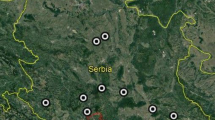Abstract
Bean germplasm collections in northern Malawi revealed the existence of diverse landraces, which have probably been maintained by the local farmers as heterogeneous mixtures since the precolonial introduction of Phaseolus vulgaris into eastern Africa. The various seed types comprising these mixtures are known by an array of local names, reflecting farmer perceptions of seed color and pattern, eating quality, plant structure, origin, and other characteristics. A principal components analysis of morphological, phenological, and agronomic metrical traits for 375 lines randomly selected from 15 landraces revealed a clinal pattern, with the northern and southern areas forming the extremes. Genetic distances, based on the first six PCs, indicated greater between-area variability than within-area variability. Bean landrace diversity in Malawi is likely the result of a complex interplay among forces that generate variability such as outcrossing and human and environmental selection.
Similar content being viewed by others
Literature Cited
Adams, M. W. 1977. An estimation of homogeneity in crop plants with special reference to genetic vulnerability in the dry bean,Phaseolus vulgaris L. Euphytica 26:665–679.
—. 1982. Plant architecture and yield breeding. Iowa State J. Res. 56:225–254.
—. 1983. Annual revíew of the Bean/Cowpea Collaborative Research Support Programs. Michigan State Univ., E. Lansing, MI.
Berlin, B., D. E. Breedlove, and P. H. Raven. 1974. Principles of Tzeltal plant classification. An introduction to the botanical ethnography of a Mayan-speaking community in highland Chiapas. Academic Press, New York.
Brush, S.B., H. J. Carney, and Z. Huaman. 1981. Dynamics of Andean potato agriculture. Econ. Bot. 35:70–88.
Centro Internacional de Agriculture Tropical. 1981. Potential for field beans in Eastern Africa. Centro Int. Agric. Trop., Cali, Colombia.
—. 1982. Annual report. Centro Int. Agric. Trop., Cali, Colombia.
Coupland, R. 1938. East Africa and its invaders. Clarendon Press, Oxford.
Edje, O. T., L. K. Mughogho, Y. P. Rao, and W. Msuku. 1981. Bean production in Malawi.In Potential for field beans in Eastern Africa, p. 54–97. Centro Int. Agric. Trop., Cali, Colombia.
Greenway, P. J. 1945. The origin of some East African food plants. East African Agric. J. Kenya 10:177–180.
International Bureau for Plant Genetic Resources. 1982. Descriptors forPhaseolus vulgaris L. I.B.P.G.R., Rome.
Janzen, D. H. 1969. Seed-eaters versus seed size, number, toxicity and dispersal. Evolution 23:1–27.
Kaplan, L. 1971.Phaseolus: Diffusion and centers of origin.In C.L. Riley, J. C. Kelley, C. W. Pennington, and R. L. Rands, eds., Man across the sea, p. 416–427. Univ. Texas Press, Austin, TX.
—. 1981. What is the origin of the common bean? Econ. Bot. 35:240–254.
Leakey, C. L. A. 1970. The improvement of beans(Phaseolus vulgaris L.) in East Africa.In C. L. A. Leakey, ed., Crop improvement in East Africa, p. 99–128. Farnham Royal, England.
Livingstone, D., and C. Livingstone. 1865. Narration of an expedition to the Zambesi and its tributaries, and the discovery of the lakes Shira and Nyasa, 1858-1864. J. Murray, London.
Martin, G. B. 1984. Genetic diversity of bean landraces in northern Malawi. M.S. Thesis, Michigan State Univ., East Lansing, MI. Univ. Microfilm International, Ann Arbor, MI.
—, and M. W. Adams. 1987. Landraces ofPhaseolus vulgaris (Fabaceae) in northern Malawi. II. Generation and maintenance of variability. Econ. Bot. 41:204–215.
Vieira, C. 1975. Change in varietal composition of bean mixtures after successive plantings. Fitotechn. Latinoamer. 8:77–84.
Westphal, E. 1974. Pulses in Ethiopia, their taxonomy and agricultural significance. Centre Agric. Pub. & Doc., Wageningen, Netherlands.
Williamson, J. 1975. Useful plants of Malawi. Univ. Malawi Press, Zomba, Malawi.
Author information
Authors and Affiliations
Additional information
Joint contribution from the Department of Crop and Soil Science and the Bean/Cowpea Collaborative Research Support Project. Approved for publication by the Michigan Agricultural Experiment Station as journal article No. 11687.
Rights and permissions
About this article
Cite this article
Martin, G.B., Adams, M.W. Landraces ofPhaseolus vulgaris (Fabaceae) in Northern Malawi. I. Regional variation. Econ Bot 41, 190–203 (1987). https://doi.org/10.1007/BF02858965
Received:
Accepted:
Issue Date:
DOI: https://doi.org/10.1007/BF02858965




